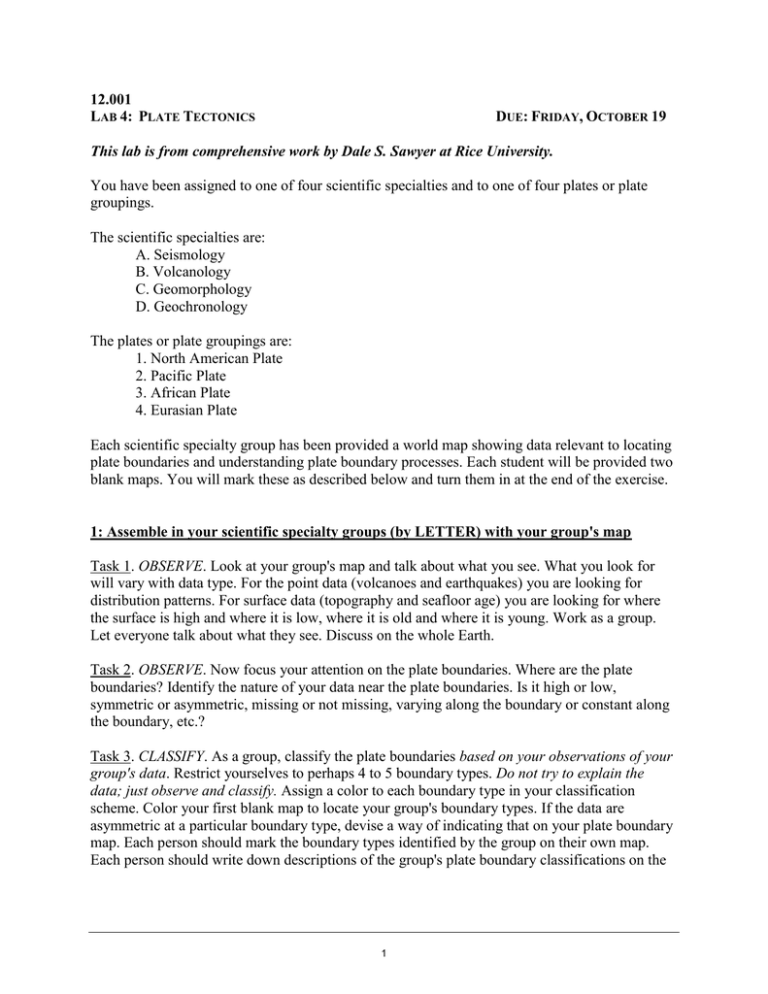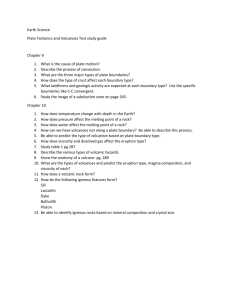12.001 L 4: P
advertisement

12.001 LAB 4: PLATE TECTONICS DUE: FRIDAY, OCTOBER 19 This lab is from comprehensive work by Dale S. Sawyer at Rice University. You have been assigned to one of four scientific specialties and to one of four plates or plate groupings. The scientific specialties are: A. Seismology B. Volcanology C. Geomorphology D. Geochronology The plates or plate groupings are: 1. North American Plate 2. Pacific Plate 3. African Plate 4. Eurasian Plate Each scientific specialty group has been provided a world map showing data relevant to locating plate boundaries and understanding plate boundary processes. Each student will be provided two blank maps. You will mark these as described below and turn them in at the end of the exercise. 1: Assemble in your scientific specialty groups (by LETTER) with your group's map Task 1. OBSERVE. Look at your group's map and talk about what you see. What you look for will vary with data type. For the point data (volcanoes and earthquakes) you are looking for distribution patterns. For surface data (topography and seafloor age) you are looking for where the surface is high and where it is low, where it is old and where it is young. Work as a group. Let everyone talk about what they see. Discuss on the whole Earth. Task 2. OBSERVE. Now focus your attention on the plate boundaries. Where are the plate boundaries? Identify the nature of your data near the plate boundaries. Is it high or low, symmetric or asymmetric, missing or not missing, varying along the boundary or constant along the boundary, etc.? Task 3. CLASSIFY. As a group, classify the plate boundaries based on your observations of your group's data. Restrict yourselves to perhaps 4 to 5 boundary types. Do not try to explain the data; just observe and classify. Assign a color to each boundary type in your classification scheme. Color your first blank map to locate your group's boundary types. If the data are asymmetric at a particular boundary type, devise a way of indicating that on your plate boundary map. Each person should mark the boundary types identified by the group on their own map. Each person should write down descriptions of the group's plate boundary classifications on the 1 back of one of their blank maps. These maps and descriptions will be turned in at the end of the exercise. 2: Assemble in your plate groups (by NUMBER) Task 1. Each person should make a brief presentation to the rest of their group about their scientific specialty's data and classification scheme. Task 2. Compare the classifications of boundary type for your plate based on each type of data. Are there boundary segments with the same end points in common among the different classifications? Can your plate group come up with a new classification scheme that now includes data from all four scientific specialties? As above, assign a color to each of your plate boundary types. If a boundary is asymmetric, be sure to devise a way to represent the asymmetry. Mark the boundaries of your plate or plate grouping on your second blank map, and write a description of the plate boundary classes you have used. The map and description should be turned in at the end of the exercise. 3: Whole class discussion One student from each Plate Group should make a presentation to the class. They should talk about their group's plate boundary classification scheme and how they classified the boundaries of their plate. You will be given an overhead transparency or dry-erase version of the plate boundary map and some markers to prepare for the presentation. Each student should turn in TWO MAPS: 1. Plate boundary map with classifications using data from your assigned scientific specialty. Descriptions of the plate boundary classifications devised by your specialty group should be on the back of the map. 2. Map with your assigned plate's boundaries classified using data from all four scientific specialties. Descriptions of the plate boundary classifications devised by your plate group should be on the back of the map. 2 MIT OpenCourseWare http://ocw.mit.edu 12.001 Introduction to Geology Fall 2013 For information about citing these materials or our Terms of Use, visit: http://ocw.mit.edu/terms.





